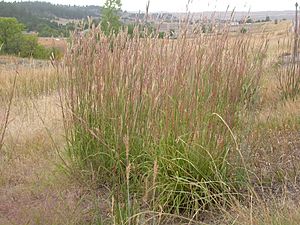Big bluestem facts for kids
Quick facts for kids Big bluestem |
|
|---|---|
 |
|
| Conservation status | |
| Scientific classification | |
| Genus: |
Andropogon
|
| Species: |
gerardi
|
Big bluestem is a tall grass with several nicknames like turkeyfoot and tall bluestem. It grows naturally in the Great Plains and other grassy areas of central and eastern North America.
Contents
What is Big Bluestem?
Big bluestem is a type of grass that lives for many years (a perennial). It grows best in warm weather (a warm-season grass) and forms clumps (a bunchgrass). It can grow well in many different kinds of soil.
Its main roots can go very deep, about 6 to 10 feet (1.8 to 3 meters)! The plants also send out strong, tough underground stems called rhizomes. These help the grass form a very strong, thick layer of roots and soil called sod.
Depending on the soil and how much water it gets, big bluestem can grow from 3 to 10 feet (1 to 3 meters) tall. The bottom part of its stem often turns blue or purple as it gets older.
Flowers and Seeds
Big bluestem flowers in the summer and produces seeds in the fall. Its flower cluster (called an inflorescence) looks a bit like a wild turkey's foot. It usually has three narrow, spike-like branches (called racemes) at the top of the stem.
Each of these branches has pairs of tiny flowers called spikelets. One spikelet in the pair has a stalk and is usually sterile (cannot make seeds). The other spikelet is stalkless and usually has a fertile flower (with both male and female parts) and a stiff bristle called an awn.
Where it Grows (Ecology)
Big bluestem is an important grass in prairies and other grasslands. It grows in tall, thick patches that can sometimes take over from other plants. These patches keep growing until something like a fire or animals grazing stops them.
This grass does not like shade and is very good at surviving fire.
Animal Visitors
Many butterflies use big bluestem as a home for their young (larvae). These include:
- Arogos skipper
- Byssus skipper
- Cobweb skipper
- Common wood-nymph
- Delaware skipper
- Dusted skipper
How People Use Big Bluestem
For Farms
Big bluestem is good food (called forage) for horses and cattle. Farmers can also cut it and use it to make hay for animals to eat later. This grass has a lot of protein, which is good for animals. Even though it's not always considered the very best food for animals, it's still a very important grass for ranchers and people who study grasslands.
For Gardens and Nature
Many plant nurseries grow big bluestem because it can handle dry weather (drought tolerance) and is native to the area. People often plant it in wildlife gardens, for natural landscaping, and in projects to bring back natural grassland habitats.
For Energy
Because big bluestem grows very big and thick (high biomass), scientists are looking at it as a possible source for making ethanol. Ethanol is a type of fuel that can be used in cars.
Symbols
Andropogon gerardi is the official state grass of Illinois and Missouri. It is also the official prairie grass of Manitoba, a province in Canada.
Images for kids
See also
 In Spanish: Andropogon gerardii para niños
In Spanish: Andropogon gerardii para niños





